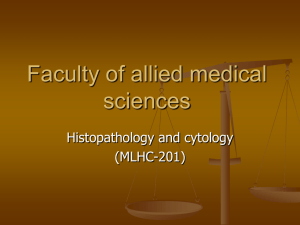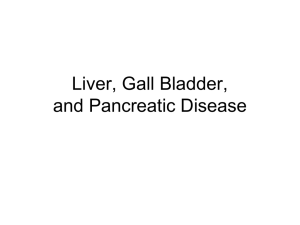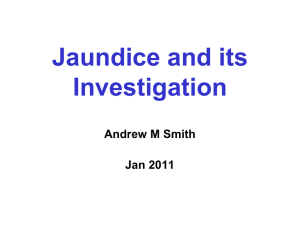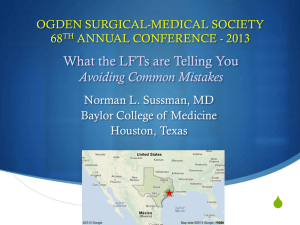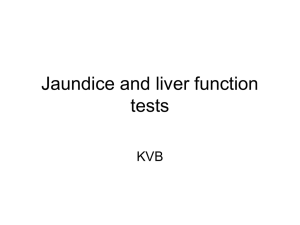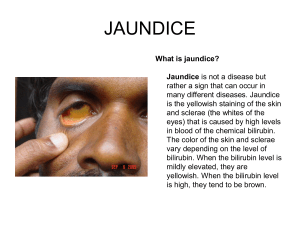Approach to a patient with Jaundice
advertisement
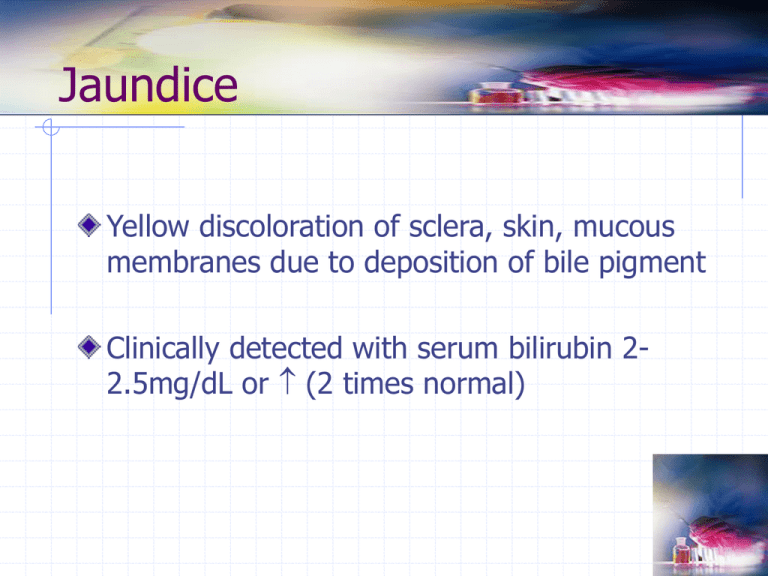
Jaundice Yellow discoloration of sclera, skin, mucous membranes due to deposition of bile pigment Clinically detected with serum bilirubin 22.5mg/dL or (2 times normal) What causes bilirubin? Prehepatic Unconjugated Hepatic mixed Post-hepatic conjugated Causes Hepatocellular disease Viral infections (hepatitis A, B, and C) Chronic alcohol use Autoimmune disorders Drugs Pregnancy Causes Parenteral nutrition Sarcoidosis Dubin-Johnson syndrome Rotor's syndrome Primary biliary cirrhosis Primary sclerosing cholangitis Drugs that may cause liver damage Analgesics Paracetamol Aspirin Non-steroidal anti-inflammatory drugs Cardiac drugs Methyldopa Amiodarone Psychotropic drugs Monoamine oxidase inhibitors Phenothiazines (such as chlorpromazine) Others Sodium valproate Oestrogens (oral contraceptives and hormone replacement therapy) Symptoms Yellow discoloration of the skin, sclerae and mucous membranes Itching (pruritus) due to deposits of bile salts on the skin Stool becomes light in color Urine becomes deep orange and foamy Clinical Features Careful history and examination Family history (Gilbert, Rotor, Crigler-Najjar, Dubin-Johnson, Sickle Cell) Healthy young person with fever, malaise, myalgias = viral hepatitis (try to locate source) Gradually develops symptoms = hepatic/bile duct obstruction (consider liver disease/cirrhosis) Develops acutely with abdominal pain = acute cholangitis sec to choledocholithiasis Clinical Features Painless jaundice in older person with epigastric mass & weight loss = biliary obstruction from malignancy Hepatomegaly with pedal edema, JVP, and gallop = CHF History that should be taken from patients presenting with Jaundice Duration of jaundice Previous attacks of jaundice Pain Chills, fever, systemic symptoms Itching Exposure to drugs (prescribed and illegal) Biliary surgery Anorexia, weight loss Colour of urine and stool Contact with other jaundiced patients History of injections or blood transfusions Occupation Examination of patients with Jaundice Depth of jaundice Scratch marks Signs of chronic liver disease Palmar erythema Clubbing White nails Dupuytren’s contracture Gynaecomastia Liver Size Shape Surface Enlargement of gall bladder Splenomegaly Abdominal mass Colour of urine and stools Laboratory Tests Pigment studies Serum bilirubin, direct Serum bilirubin, total Urine R/E for bilirubin and urobilinogen Alkaline Phosphatase Liver aminotransferrase levels AST ALT Elevated levels usually indicate cellular damage to the liver > 70% of liver cells may be damaged before LFT’s become elevated Blood Studies Serum Ammonia Liver converts ammonia to urea. Ammonia rises in liver failure Protein Studies Serum albumin Low levels seen with liver disease Serum Globulin Elevated levels with advanced cirrhosis and chronic active hepatitis CBC PT Other labs pertinent to history Coombs test Hb electrophoresis Viral hepatitis screen ULTRASOUND Tumor Marker Alpha-fetoprotein (AFP) Increased levels are seen with hepatic carcinoma Prothrombin Time (PT) Time required for a firm fibrin dot to form In liver dysfunction, increase clotting time with increased risk of bleeding Liver Biopsy Used to obtain a specimen of liver tissue Done under local anesthesia Autoantibody and immunoglobulin characteristics in liver disease Liver disease Auto antibodies Immunoglobulin Primary billiary cirrhosis High titre of antimitochondrial antibody in 95% of patients Raised IgM Autoimmune chronic active hepatitis Smooth muscle antibody in 70%, antinuclear factor in 60%, Low antimitochondrial antibody titre in 20% Raised IgG in all patients Primary sclerosing cholangitis Antinuclear cytoplasmic antibody in 30% Summary An isolated raised serum bilirubin concentration is usually due to Gilbert’s syndrome, which is confirmed by normal liver enzyme activities and full blood count Jaundice with dark urine, pale stools, and raised alkaline phosphatase and gamma-glutamyl transferase activity suggests an obstructive cause, which is confirmed by presence of dilated bile ducts on ultrasonography Jaundice in patients with low serum albumin concentration suggests chronic liver disease Patients with high concentrations of bilirubin (>100 micro mol/l) or signs of sepsis require emergency specialist referral Imaging of the bile ducts for obstructive jaundice is increasingly performed by magnetic resonance cholangiopancreatography, with endoscopy becoming reserved for the therapeutic interventions Pre-Hepatic Disorders Gilberts Failure to conjugate 2-5% Autosomal recessive Asymptomatic Bilirubin Unconjugated Normal ALT/ALP Worse if infection, miss a meal Haemolysis Excess bilirubin production Unconjugated Bil ++ Normal ALP/ALT Low Hb/retics++ Splenomegaly Pigmented gallstones Hepatic Disorders & Hepatic Failure Acute & Chronic Liver Disease Acute Drugs Viral Alcohol Autoimmune Chronic Biliary Primary biliary cirrhosis Primary sclerosing cholangitis Liver cell damage (cirrhotic) Alcohol Autoimmune Viral* Haemochromatosis* Wilsons* A1AT* Physical Findings Acute Moderate liver enlargement, tenderness, +/- jaundice Chronic Sallow complexion, extremity muscle atrophy, palmar erythema, spider nevi, testicular atrophy, gynecomastia, splenomegaly, ascites Investigations ACUTE LIVER INJURY LFTs Hepatitic ALT/AST +++ CHRONIC LIVER DISEASE LFTs Albumin Normal FBC Normal PT Albumin Low FBC Mild elevation Exception- paracetomol Hepatitic ALT/AST +++ Cholestatic ALP/GGT+++ Pancytopaenia Elevated wcc PT Elevated Blood tests for liver disease Liver autoantibodies Anti-mitochondrial Anti-Smooth muscle Immunoglobulins IgM IgG IgA Ferritin/TIBC PBC AICAH PBC AICAH Alcohol Haemochromatosis Gross specimen of cirrhosis of the liver Post-Hepatic Disorders Intrinsic to the ductal system Gallstones Surgical strictures Infection (cytomegalovirus, Cryptosporidium infection in patients with acquired immunodeficiency syndrome) Intrahepatic malignancy Cholangiocarcinoma Extrinsic to the ductal system Extrahepatic malignancy (pancreas, lymphoma) Pancreatitis CASE SCENARIO A 54 years old female is presented in emergency department with complaints of low grade fever, nausea and loss of appetite for last 10 days. now she is worried because of yellow discoloration of sclera and dark colored urine for one day. What physical signs you can suspect in this case? , CASE SCENARIO On examination, she has fever of 100F.she is jaundiced and having tender hepatomegaly. How will you investigate this case ? CASE SCENARIO Bilirubin 10mg/dl ALT 1593IU Alkaline phosphatase 840IU Hb 12.3 TLC 8900 Platelets 250000 PT 3 seconds prolong Serum albumin 3.6mg/dl What is your likely diagnosis ? CASE SCENARIO Hepatitis Hepatitis Hepatitis Hepatitis A B C D CASE SCENARIO How will you differentiate hepatitis A and hepatitis E infection ? How will you manage this case ? CASE SCENARIO Bed rest Increase oral juices intake in anorexic patients Anti emetics Parenteral feeding if severe anorexia and vomiting Vitamin and liver supportive agents

